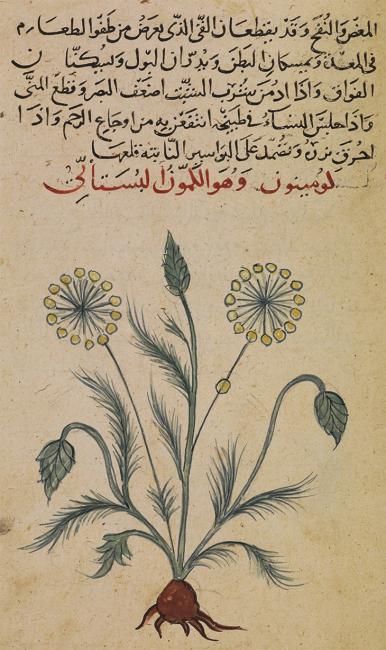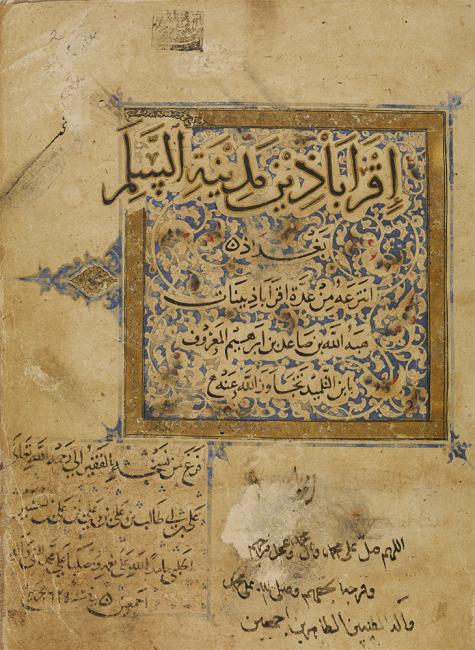Overview
Pharmacology is one of the medical fields in which the Arabs excelled, an area that developed its own specialist literature, in addition to sections in general medical encyclopaedias. Some books were devoted to ‘simples’ (mufradāt), that is, individual plants, minerals or animal products used in medicine. Others, known as formularies (aqrābādhīnāt) – books containing recipes for preparing medicines – listed compound recipes (murakkabāt). In such recipes a number of simples were combined into a specific formulation (powder, ointment, tablet or most commonly, syrup) in order to treat a given ailment.

All the Perfumes of Arabia
The most commonly used words for pharmacy and pharmacists, ṣayḍalah and ‘aṭṭār, actually mean sellers of sandalwood or perfume, indicating the close relationship between substances that we use today for perfume or cooking, and medieval medicine. If a person fell ill, surgery would be a last resort; the first attempt at a cure would be changing their diet, and if that didn’t work, drugs would be used – and this is where formularies come in.
Simples from Outside the Arab World
Books on medicine were among the first scientific works to be translated into Arabic during the eighth–tenth centuries CE. Pharmacy in Arabic is based on the Greek tradition, featuring the works of Galen and Dioscorides on simple drugs. A list of simples could include what today might be considered herbs and spices, such as basil, mint, ginger and pepper; but also perfumes like musk, violet, and jasmine oils. While Dioscorides’ work was extensively quoted in later compilations, books were also written about the drugs not found there. These would be mostly plants, but also some minerals and animal products that came from India, South-east Asia and China, and had not been known to the Greeks and Romans.
The same process of adding to classical knowledge can be seen in formularies, which include recipes with titles deriving both from Greek, such as theriac (tiryāq), originally a cure for snakebites, and from Sanskrit, for example triphala (iṭrīfāl), a multi-purpose drug containing three kinds of myrobalan (ihlīlaj), an Indian plant.
Hospital Handbooks and Self-Help Guides
A formulary was called an aqrābādhīn, from the Greek graphidion (γραφίδιον), a list or registry. In such works, which can either be independent books or sections of larger ones, the author presents a compilation of compound prescriptions for many ailments. Most commonly, each chapter is devoted to a particular form of preparation. Within this basic structure, there is great room for variety: often, similar preparations such as syrups (ashribah), robs or thickened fruit juices (rubūb), and jams (murabbayāt) would be placed together in a single chapter. Another common feature was a chapter devoted to toothpastes or to eye medicines. Most surviving formularies come from Baghdad or Cairo, and many of them were for u6se in public hospitals. One such formulary using the format described above is the Great Formulary (Aqrābādhīn al-kabīr) of Ibn al-Tilmīdh (died AD 1154 or 1165).

Not everybody was treated in hospital. It is possible that most people stayed at home, to be treated in familiar surroundings. Doctors prescribing for such patients may have used an alphabetical handbook of medicines, like Minhāj al-bayān fīmā yastaʿmiluhu al-insān (The Clear Path on What [Drugs] People Use), written by Ibn Jazlah of Baghdad (died AD 1100). In this book, unlike the hospital formularies, both compound medicines and simple drugs appear together. For example, all catapasms or medicinal powders (singular safūf) are found together under the letter S (sīn), followed by the simple saqamūniyā (scammony).
![Title page of an early copy of Ibn Jazlah’s The Clear Path on What [Drugs] People Use (Or. 7499, f. 1r)](https://www.qdl.qa/sites/default/files/styles/standard_content_image/public/or7499_0010_web.jpg?itok=4hu-YGqA)
Another option may have been to consult the local pharmacist, rather than paying for a physician. The only known formulary composed by a pharmacist is called Minhāj al-dukkān (‘How to Manage a Pharmacy’), written in Cairo by a Jewish pharmacist named Kūhīn al-‘Aṭṭār (died AD 1260), as advice for his son. This work was extremely successful, and has been in continuous use up to the present day.
The combination of drugs from all over the known world to enhance old medicines and create new ones made Arabic-language pharmacy a very powerful tool in the attempt to preserve health among the well, and restore health to the sick (the purpose of medicine, according to Avicenna). Many of the recipes are now known to be effective against the symptoms they claim to treat, and these medieval books contributed to the basis of modern herbal medicine.